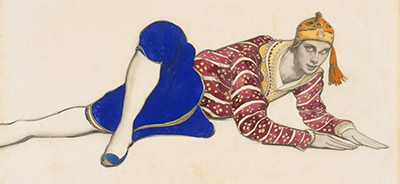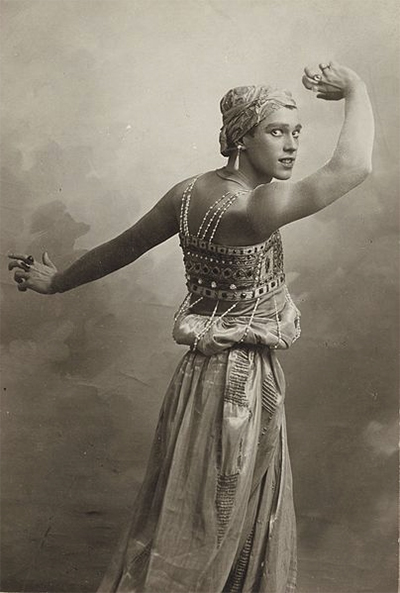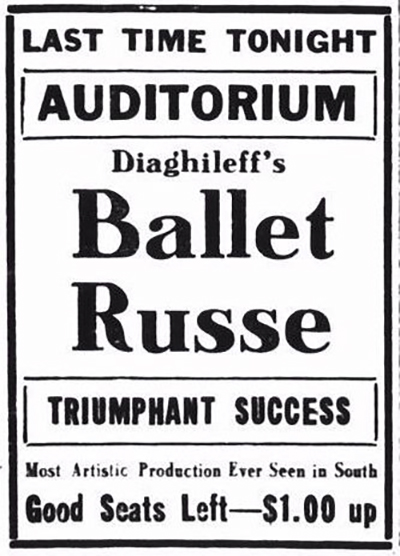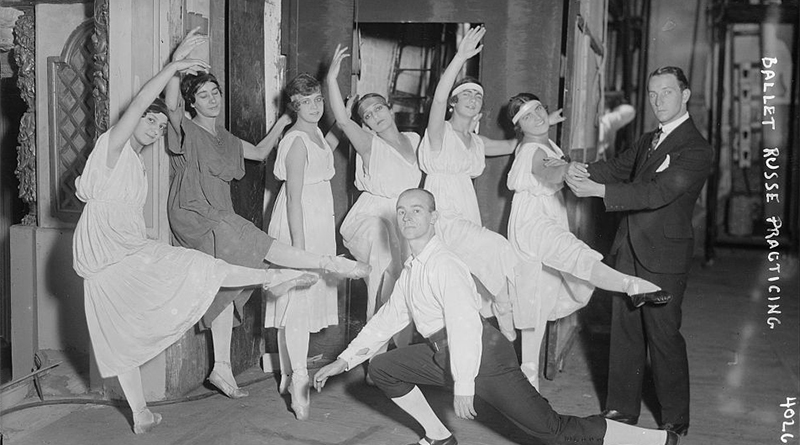The Ballets Russes rehearsing in New York City, Oct 1916.

Watercolor and graphite on paper.
Collection of the McNay Museum, Gift of the Tobin Foundation for Theatre Arts.
In early December 1916 Vaslav Nijinsky, the greatest dancer alive, spent a week in Texas.
From October 1916 until February 1917 the gypsy-like group of dancers that were The Ballets Russes, arguably the most significant artistic enterprise of the 20th Century, toured 56 cities and towns across the USA. The company, an estimated 150 dancers, musicians, crew and Russian mothers, traveled from coast to coast in a specially customized twelve-car Pullman train – known as The Ballets Russes Special. The mother of famed Russian Ballerina Olga Spessivtseva christened the company “The Circus of Sergei de Diaghileff.”
On this tour, however, the company was not led by the indomitable Sergei Diaghilev (who remained in Europe with some of the principal dancers) but by artistic genius Vaslav Nijinsky.
Nijinsky, born in Kiev on March 12, 1889, would become the most famous male dancer of his generation. The son of two dancers, he trained at the Imperial Ballet School, St. Petersburg, before being accepted into the Imperial Ballet Company. Nijinsky quickly became a household name in Western Europe after he joined the première season in Paris of Sergei Diaghilev’s Ballets Russes in 1909.
His talents, together with Mikhail Fokine’s choreography, brought the role of the male dancer to the center of ballet once more – having been overtaken by the rise of the ballerina throughout the 19th Century. Nijinsky, as principal dancer of the Ballets Russes, would create roles in Le Carnaval, Les Sylphides, Le Spectre de la Rose, Schéhérazade, Petrushka, Le Dieu Bleu, Daphnis et Chloé, and Narcisse. He would become a pioneer in modern dance with his own choreographies L’Après-Midi d’un Faune, Jeux and, most famously, Le Sacre du Printemps.
Nijinsky was fired from the Ballets Russes in 1913, having allegedly broken his contract, but his controversial marriage to Hungarian socialite Romola de Pulszky was almost certainly a factor in Diaghilev’s decision (Nijinsky and Diaghilev had previously been romantically involved). He would not be associated with the Ballets Russes again until 1916 during the Great War.

Watercolor, metallic paint, and graphite on paper.
Collection of The McNay Museum, Gift of Robert L. B. Tobin.
Nijinsky was interned in Hungary and placed under house arrest. Diaghilev, allegedly with the assistance of the King of Spain, was able to secure his release on the premise that he would join the Ballets Russes in North America. Nijinsky joined the tail-end (appearing in New York City only) of the first Ballets Russes Tour. This US tour, in the early part of 1916, covered 17 cities (none in Texas) in four months.
The company noted a marked change in Nijinsky, who was hostile and suspicious of everybody. Diaghilev was anxious to secure the future of the company and entered into negotiations for a second tour. The managing company, The Metropolitan Opera, would only agree if Nijinsky would join, and Nijinsky in turn would only agree if he had complete control of the company.
So it transpired that in the fall of 1916, together with his wife and small daughter, the greatest dancer of the first half of the 20th Century arrived in New York City to lead the forthcoming coast-to-coast tour of the Ballets Russes. Diaghilev and a small group of dancers and staff remained in Rome where they worked on new productions – a stipulation of Nijinsky’s leadership. The 28-year old would also choreograph his last ballet, Till Eulenspiegel, in New York prior to the tour. This, interestingly, was the only ballet for the company that Diaghilev never saw, as it was only performed on this tour.
Tensions and the absence of many of the senior dancers, and of Diaghilev himself, coupled with the stresses of war and Nijinsky’s increasingly odd behavior (he was already showing signs of the mental illness that would later consume him) have all caused this second tour to be viewed as a failure – but was it?
Curious, I began researching this tour and found that, although it was a financial failure and Nijinsky’s management was not without its issues, the company was greeted with a glowing reception wherever they went and was in fact an artistic success.
After two weeks in NYC and five weeks performing in 16 cities down the East Coast, the Ballets Russes arrived in Texas, their first stop, Houston – where it seems they were the talk of the town!
The Houston Daily Post began running articles about the company’s arrival from the beginning of November as part of the Metropolitan Opera’s (the company managing the tour) publicity policy to build up momentum.
 On Nov. 1 it was reported that an F. C. Schang, representing the Metropolitan Opera, had arrived to make preparations for the company. The article stated that “The Diaghileff organization is unlike any other production in that it combines all forms of dramatic entertainment in one. Therefore in the ballet as Houston shall see it, there will be the best of music, marvelous costume and scenic creations by Bakst, stirring pantomime drama from the world’s folklore and dancers whose technique is unequaled the world over.”
On Nov. 1 it was reported that an F. C. Schang, representing the Metropolitan Opera, had arrived to make preparations for the company. The article stated that “The Diaghileff organization is unlike any other production in that it combines all forms of dramatic entertainment in one. Therefore in the ballet as Houston shall see it, there will be the best of music, marvelous costume and scenic creations by Bakst, stirring pantomime drama from the world’s folklore and dancers whose technique is unequaled the world over.”
The momentum continued to build with daily articles and advertisements from the last week of November into the first week of December. The exotic costume and set designs of Léon Bakst that had shocked and thrilled Paris six years before were a continued source of amazement, with countless articles devoted to them.
On Nov. 25 an article in The Houston Daily Post stated, “If there were no exciting music with the Russian Ballet, if there were even no dancing – if there were nothing but the costumes of Léon Bakst – Serge de Diaghileff’s Ballet Russes … would still present the glittering spectacle that has set Europe afire for the last six years, and that now promises to inflame America in the same manner.” The use of the highest quality fabric and real gems proved fascinating; “It is doubtful if the Queen of Sheba, Solomon in all his glory, or any one of his thousand wives, were arrayed like Serge de Diaghilieff’s Ballets Russes in the splendour of their Bakst costumes.”
A week before the company was due to arrive, the Houston Daily Post ran an article calling to attention the range of “books and a few exceptionally interesting magazine articles on the subject of the ballet and the Russian dancers” housed at the Houston Library. Ten books and articles were listed, ranging from works on Bakst and Nijinsky to The Russian Ballet by Ellen Terry. It seems that Houston couldn’t get enough of the Ballets Russes!
On Dec. 1 the Houston Daily Post ran their most curious article to date, entitled “Nothing Like a Stencil to Keep my Lady Warm.” This piece looked at Leon Bakst’s style of stenciling costumes – except that the journalist, in a tongue-in-cheek manner, suggested that the costumes themselves were in fact simply stenciled onto the body! The article began “You might just as well be stenciled now as later on. From the moment the Serge Diaghileff Ballet Russes starts its two days’ engagement … you will simply have to be stenciled or move to Galveston!”

Using the Bakst- designed ballet Cleopatra as an example, the writer explains; “The Cleopatra costumes consist of some stenciling, a great many pearls, a yard or so of wonderfully embroidered silk and a thousand or more safety pins – because Cleopatra must be wound into her clothes every night, and they are pinned on securely with safety pins.”
Bakst’s exotic and colorful designs had influenced fashion in Paris for the previous six years; now his principles of design had reached Texas. Women who followed these principles, the writer explains, “got rid of their petticoats five years ago, and their stays two years since. But for the last six months they have been nonplussed as to what to do next. There seemed to be nothing more to take off. Miss Fifth Avenue had nothing to wear and she wore it.”
It seems the new notion of stenciling had come in just in time! You can even choose your pattern, the article clarifies; “… nothing to prevent you from wearing the stenciled likeness of your beloved … Or you may have your candidate for the presidency or the baby’s latest photo blown on you!” I wonder if this fashion took off in Texas?!
After much anticipation, the Ballets Russes arrived on the 12-car Ballets Russes Special into Houston on Sunday, Dec. 3, 1916. The papers reported excitedly that Nijinsky and his wife spent the afternoon on a motor ride, whereas the rest of the exotic troupe “took their cameras – most of them are camera fiends – and shot up the town in a ‘picturesque’ way … their presence and evident foreign nationality attracting much attention as they walked along the street, most of them wearing overcoats.” Many of the Company stayed at Houston’s Rice Hotel, a luxury only possible when they were in a city for more than one performance. Most nights the company slept on the train.
The Ballets Russes opened on Monday night at the City Auditorium. Sadly this building was pulled down in the 1960s, having hosted some of the most famous acts from around the world, to make way for the Jesse H. Jones Hall for the Performing Arts. The company performed Les Sylphides (with Vaslav Nijinsky and ballerinas Olga Spessivtseva and Lydia Lopokova), Schéhérazade, Le Spectre de la Rose (with Nijinsky and Lopokova) and Prince Igor.
The review the next day stated that the company “in every way met the highest expectations of a most discriminating audience.” The reviewer went on to describe each ballet that had been performed, curiously fusing Les Sylphides and Papillons – which had not actually been danced. Most significantly, this program first introduced the Houston audience to Nijinsky, with the reviewer proclaiming that, “This dancer is a wonderful specimen of manhood.” These two nights would be the only times that Nijinsky would ever perform in Houston.

The following night the company, albeit to a slightly smaller audience (still impressive considering the Auditorium allegedly seated 7,000), presented Cleopatra, Prince Igor, and Le Carnaval. “Those who attended were enthusiastic in their applause and the musicians and dancers were not allowed to have the lonesome feeling which no doubt afflicted the box office,” wrote a reporter from The Houston Daily Post.
The V&A Museum London holds a fascinating collection of expense receipts from the Company and this tour. These provide an incredible insight into the day to day running of the Ballets Russes. The receipts show that laundry was sent out in Houston on both days to the Eureka Laundry at 610 Travis Street. This included 15 bath towels, 51 face towels and three pairs of tights!
On Wednesday, Dec. 5, the company and the Ballet Russes Special arrived in Austin, where they performed Les Sylphides, Schéhérazade and Le Spectre de la Rose at the Majestic Theatre. Now renamed the Paramount Theatre, the Majestic still stands today on Congress Avenue. On Thursday, Dec. 6 the Ballets Russes performed Les Sylphides, Scheherazade and Le Carnaval at the Coliseum Theatre, Dallas. As in Houston, newspaper campaigns in Austin, Dallas and Fort Worth had begun well over a month before. The Dallas Times Herald reported, “Those that were lucky enough to be present … saw a performance that kept them spluttering around for new adjectives and left them a little dazed when it was over.”
The week ended with two nights in Fort Worth, where the company performed at the Fair Park Coliseum. On that Friday they danced Les Sylphides, Cleopatra, Le Spectre de la Rose and Prince Igor, and on the Saturday night Carnaval, L’Apres-midi d’un Faune, Le Spectre de la Rose and Schéhérazade.
Fort Worth seemed enamored of Nijinsky, with frequent articles running in the local newspapers. These included transcripts of long interviews it is highly unlikely the great dancer ever gave! He was known not to speak much and spoke little to no English.
Character dancer Lydia Sokolova later described how “he moved on the balls of his feet, and his nervous energy found an outlet in fidgeting: when he sat down he twisted his fingers or played with his shoes … he hardly spoke and seemed to exist on a different plane.”

In Fort Worth more laundry was sent out to Johnson’s Towel Supply. This included 138 face towels, 12 pairs of drawers, 1 undershirt and 1 pair of stockings! Laundry could not be done on the train and appears to have only been sent out when the company was in a city more then one night.
The company stayed in the glamorous Westbrook Hotel, which had opened in 1910 (it was demolished in 1978) and racked up a bill of $39.48 in telegrams and phone calls to NYC – nearly $800 in today’s money. Many of the telegrams were to Diaghilev in Rome or the Metropolitan Opera management in New York City.
After a week in Texas with performances in four cities, the Ballets Russes continued on its way – next stop Oklahoma. Houston reviewer Upshur Vincent summed up the 1916 experience, “The Ballets Russes – the most entrancing entertainment that has yet come the Houston way. It is, in all necessary ways, perfection.”
In 1939, a reporter wrote in The Rambler (Fort Worth, 8th November), “America’s introduction to the Russian ballet was through Vaslav Nijinsky, genius of dance, 20 years ago. Although it was an artistic success, it was a box-office failure.”
This was the last tour of the Ballets Russes in the USA and the last time an American audience would see Nijinsky dance. It would be nearly twenty years until the Ballets Russes de Monte Carlo (the heir to the Diaghilev Ballets Russes) would visit Texas. For four consecutive years the Ballets Russes de Monte Carlo would spend either Christmas or New Year in Texas from December 1934 to January 1938 visiting: Dallas, Austin, San Antonio, Houston, El Paso, Abilene, Amarillo and Waco. And as we well know now, those visits continued off and on through the 1960s at which point Texas began to grow its own ballet companies.
—CAROLINE HAMILTON

